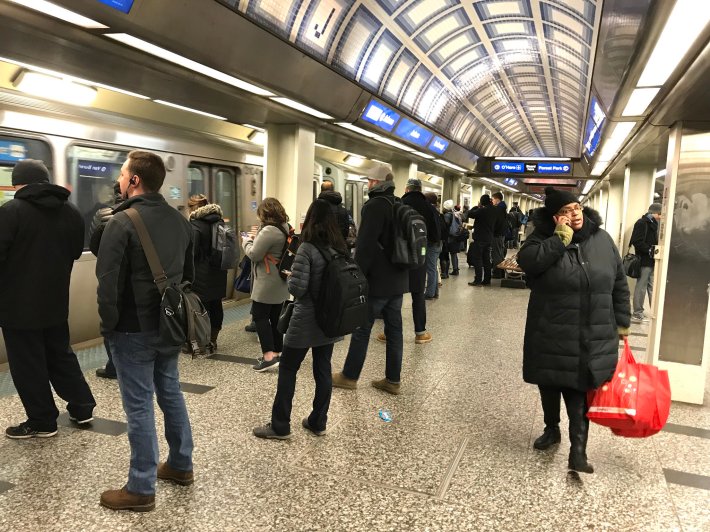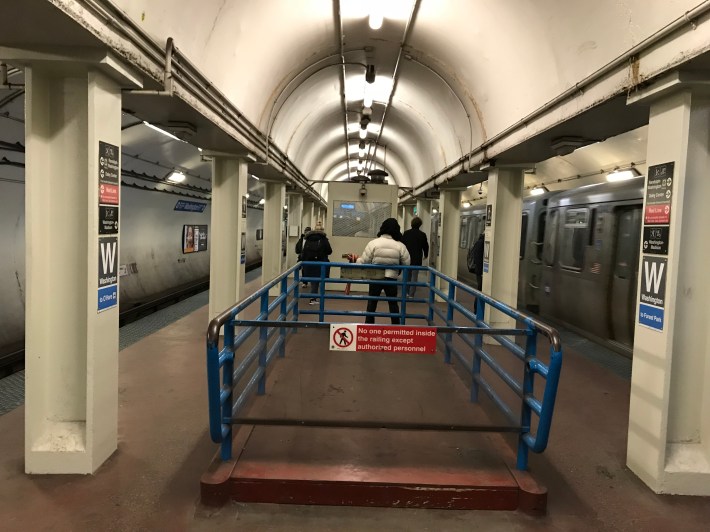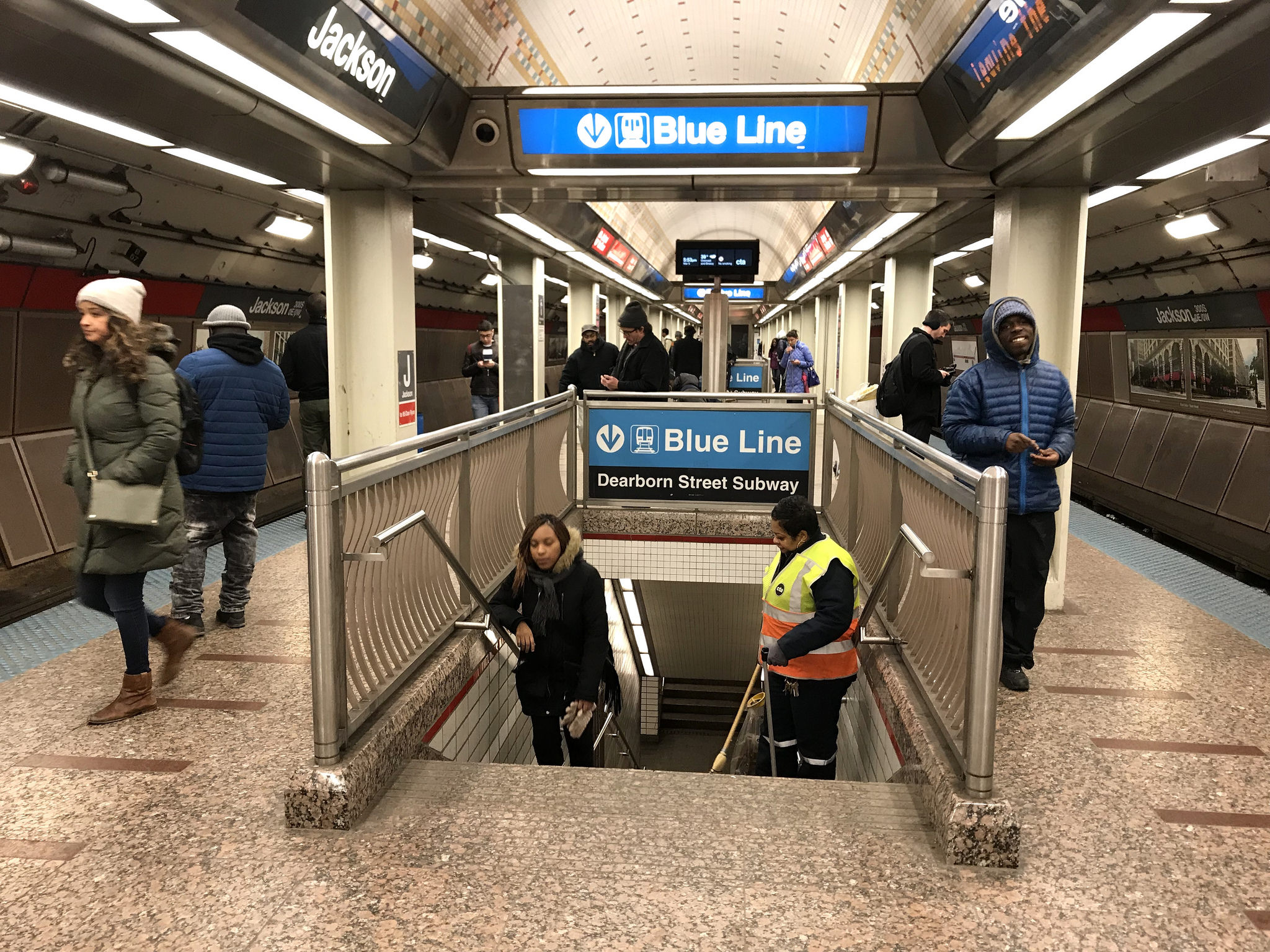[Streetsblog Chicago editor John Greenfield publishes a weekly transportation column in the Chicago Reader. We syndicate the column on Streetsblog Chicago after it comes out online.]
I'm not going out on a limb saying that most CTA subway stations are nothing to write home about. They're relatively cramped tunnels whose cream-colored walls are often streaked with grime and worn, brown platforms are caked with dirt. Corners reek of garbage or worse.
The dingy underground spaces—especially those that haven't been rehabbed—are downright embarrassing when compared to the clean, spacious, textured-concrete vaulted ceilings of, say, the Metro system in Washington, D.C., let alone the art-filled, architecturally significant stations of the Paris and Moscow subways.
No one expects the CTA to be spick and span—it has thousands of riders a day. But could more regular cleanings encourage more people to use the system, increase ridership, and ultimately, the CTA's bottom line?
If you use the lifts at CTA stations on a regular basis, you're familiar with the all-too-common indignity of the urine-flooded elevator car. But at the CTA's Washington stop on the Blue Line, dark urine stains perpetually line the outer walls around the stairs and escalators that take you to and from the platform.
Dirt and grime is all over the place at the Washington station, which with 3.8 million rides in 2016 was the busiest stop on the line other than O'Hare Airport. The grit's embedded in the floors and the blue edging on the platforms. It runs up and down support columns, covering lights, and even on and around recycling containers encouraging passersby to "keep the CTA clean." At the Red Line's Jackson stop on a recent visit, the platform is in better shape, but the tracks are littered with airplane liquor bottles, banana peels, a fingerless glove with a shamrock on it, and pizza slices. (There's no sign of Chicago's answer to the New York Metro's viral video star, Pizza Rat.)
"The CTA obviously needs to do some additional work with cleaning up its els and subways," says Bill, a sales consultant who lives in the South Loop and was waiting for the train. "It's just unacceptable."

At the Blue Line's Jackson stop, which was more recently renovated with a pleasing blue-and-white ceiling mosaic, the platform seems moderately free of filth. There, EPA employee and Oak Park resident Pamela Grace tells me that station cleanliness seems to fluctuate by location. She says that like most outdoor stations exposed to wind and rain, the Oak Park Avenue stop is usually fairly clean, and she saw CTA staffers emptying garbage cans there that morning. "But it gets a little hairier down the line, particularly Cicero and Pulaski," she says.
The cleanliness problem appears particularly bad in the winter, when cold temperatures outside seem to prevent much maintenance inside. A CTA worker who was quickly spot-cleaning the Washington stop last week admitted the CTA almost never washes the stations down when it's below 35 degrees. Asked the last time such a cleanup was done, she couldn't remember—she says it was possibly a year ago.
The CTA also can't remember.
When I first ask about how often the stations are more thoroughly scrubbed spokeswoman Catherine Hosinski tells me the busiest stations are "deep cleaned" every two weeks. She says the less busy stations are done every five to six weeks.
"CTA places a high priority on cleanliness," she writes in an e-mail, noting the system's 2018 budget for janitorial services is $24.8 million.
She claims that on a daily basis cleanings include sweeping, spot mopping, and wiping down of the station houses, platforms, and elevators several times as well as removing graffiti. The work also includes cleaning escalator and stairway handrails; wiping down stainless steel surfaces like turnstiles, the customer assistant booth, and vending machines; cleaning station entrance doors and windows; and emptying garbage.

Also on a daily basis, workers use foaming cleaner, alkaline disinfectant, degreaser, bleach, stainless steel cleaner, graffiti remover, and "spill control solidifier"—a powder that turns blood and other body fluids into a gel to eliminate splashing, she says.
Deep cleanings, meanwhile, involve a more thorough version of the daily ritual, plus a major scrubbing or power washing of all floors. Crews also regularly clean areas not accessible to the public, including outside lighting and windows, elevator pits, platform weather canopies, break rooms, and offices, she says.
But when I push for evidence of the deep cleanings, she admits they are done far less frequently. The eight downtown stations in the Blue Line were cleaned a total of 50 times last year. The Washington station is deep-cleaned just three times—far less than every two weeks.
Hosinski acknowledges that CTA facilities are sometimes less than pristine. "With about 1.5 million weekday rides and service provided at nearly all hours of the day, spills, accidents and other incidents are bound to occur," she says. She adds that customers should feel free to let CTA employees know when they see a major mess
Grace suggests that riders should cut CTA workers some slack as they try to accomplish the Sisyphean task of keeping the massive system clean at all times. "You're literally cleaning up behind hundreds of thousands of people every day, so if you can keep the trash off the subway for the most part, you're doing a good job," she says.
And even if some of the stations aren't pretty, there is one thing that riders and CTA staff agree on.
"Chicago is a great, clean city. New York is the pits," says Bill, the South Loop resident.
"It's dirty. It's bad," acknowledges the CTA worker. "But everybody says it's cleaner than New York."




